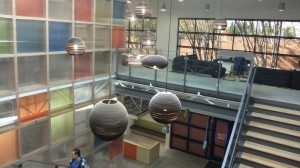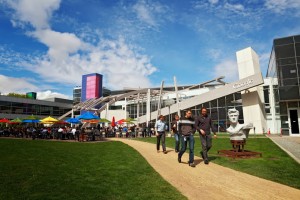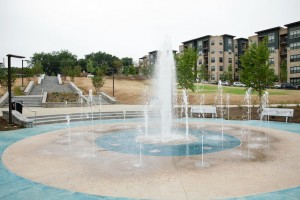Share This
Related Posts
Tags
Healthy Places
By Yardi Blog Staff on Mar 27, 2014 in News
The built environment has a huge impact on every aspect of human life. The places in which we live, work and play can affect both our mental and physical wellbeing. As a promoter of healthy communities, the Urban Land Institute (ULI) has launched a series of projects aimed at encouraging sustainable living choices among urban dwellers, including Ten Principles for Building Healthy Places and Intersections: Health and the Built Environment. The two reports are part of the Building Healthy Places Initiative, a multifaceted program launched in July 2013 by ULI to purposely “leverage the power of the Institute’s global networks to shape projects and places in ways that improve the health of people and communities.”
Over the next couple of years, ULI and its members will explore issues of land use, urban design and development so as to delineate clear paths which will eventually lead to the creation of nurturing living environments, conducive to active lifestyles, social interaction, and a higher quality of life in general.
“We are looking at city building through the lens of health and wellness as a way to measure sustainability and long term prosperity,” said ULI Chairman Lynn Thurber, chairman of LaSalle Investment Management in Chicago, in a written statement. “The Building Healthy Places Initiative is an extension of ULI’s ongoing pursuit of sustainable, thriving communities worldwide. The difference is that, with this effort, wellness is the intent, the designated outcome – not just an additional benefit of thoughtful design and development. Our focus will be on defining the role land use plays in creating healthy places for all generations.”
Intersections: Health and the Built Environment builds on the premise that intelligent urban design can help put an end to many of the ills currently menacing communities all across the United States, including obesity, growing toll of chronic disease, air and water pollution and surging healthcare costs. By facilitating interaction and collaboration among the primary influencers of the built environment – developers, builders, designers and financiers – and advancing understanding of what works when it comes to health, ULI strives to help cities prosper and become hubs of innovation and health.
Opportunities for active lifestyles, availability of healthy and affordable housing options, proximity to nature, easy access to green recreational spaces and mass transit – these are all key features of a sustainable community, according to the Intersections report.
Healthier communities or projects that are designed and executed in a way that enhances health will also acquire a higher market value and will be able to retain that value longer, which will translate in turn into a higher return on investment for their investors and developers.
Market research shows that there is a huge demand for mixed-use, mixed-income, walkable communities right now, expressly voiced by Millennials and Baby Boomers alike, who expect their homes to accommodate their lifestyle choices as well.
Intersections says that 68 percent of Gen Y-ers think proximity to a park is an important consideration, when they ponder over where they want to live. 76 percent of Gen Y thinks walkability is important. Homes located in neighborhoods with good walkability are worth $34,000 more on average than similar homes in neighborhoods with average walkability.
Although surveys show that the majority of the 55- to 64-year-old demographic prefers to “age in place,” those who do move increasingly want to live in areas where they can walk and bike to amenities such as restaurants, libraries, and cultural activities.
Amenities such as proximity to transit, storage for exercise equipment within buildings, easy access to parks and open space, as well as tech offerings and shared biking systems can act as leverage when it comes to attracting and retaining residents of all ages. Additionally, studies have shown that residents of mixed-use livable communities with transit options do indeed weigh less, are more physically active, and experience less chronic disease.
Healthy places can also act as economic catalysts, generating community growth and creating new business opportunities for its population. Atlanta’s BeltLine is an illustrative example of eco-friendly development that places great emphasis on livability and well-being, bringing forth a set of physical activity–promoting amenities including public parks, multiuse trails and transportation options.
The BeltLine reuses 22 miles of historic railroad corridors circling downtown Atlanta and connects 45 neighborhoods to each other and to the entire Atlanta region through improved infrastructure. When complete, the project will feature 33 miles of multiuse trails, 1,300 acres of parks, and 5,600 units of affordable housing.
On the same note, Google has used healthy living as an amenity to attract and retain the brightest and best staff. The high-tech giant’s corporate headquarters in Silicon Valley, the Googleplex, stands out as the epitome of sustainable development. Among a series of innovative features, the campus showcases an on-site organic garden that supplies a portion of the on-site cafes’ produce; community bikes and scooters for getting around; beach volleyball facilities; a bowling alley; over 25 cafeterias; more than 100 micro-kitchens and seven fitness centers; high ceilings and lots of natural light; LEED and Cradle to Cradle – certified furniture and products; photovoltaic and solar panels; and a collaborative workplace design that fosters creativity and productivity.
“Increasingly, cities are actively seeking to encourage healthy living choices to attract new investments and gain a competitive advantage,” noted ULI Chief Executive Officer Patrick L. Phillips. “This is not just about building a walking trail or upgrading a fitness center. Building healthy places is about improving all aspects of the environment in which people live, from the air we breathe to the places where we work. This involves rethinking what, where and how we build.”
The second report of the series, Ten Principles for Building Healthy Places, seeks to advance ten practical philosophies that developers and local leaders can embrace to transform their communities into healthy living environments, nurturing and supportive of their members. The ten principles include:
- Put People First
- Recognize the Economic Value
- Empower Champions for Health
- Energize Shared Spaces
- Make Healthy Choices Easy
- Ensure Equitable Access
- Mix It Up
- Embrace Unique Character
- Promote Access to Healthy Food
- Make It Active
To learn more about ULI’s Building Healthy Places Initiative, visit www.uli.org/health. Copies of both reports mentioned above available for download.



